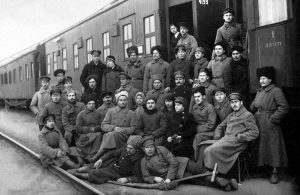Recently demobilized soldiers, 1917. Source: https://russiainphoto.ru/
By August Hagemann
On November 6th, 2017, Miami University’s Havighurst Center hosted the fifth speaker in its Fall Colloquium Series – Professor Eric Lohr of American University. Lohr focused on the topic of an article he had co-authored with Lafayette College’s Joshua Sanborn, and which will eventually become the final chapter of a book he and Sanborn are writing. Through this talk, his article, and his upcoming book, Lohr first seeks to combat the idea that Russia was economically backward and ill-equipped for World War I, and then to demonstrate that the Bolshevik Revolution was possible only because of substantial demobilization that took place in wake of the February Revolution.
To support his point, Lohr chose to focus on Russia’s material and ideological mobilization for war. He pointed out how, on paper at least, the Russian army was more prepared at the beginning of 1917 than it had been throughout the entire rest of the war. In terms of economic production geared toward the war, food, and manpower, Russia was more than capable of fighting both the Ottoman Empire and Austria-Hungary, though even in theory Germany was still a formidable opponent. Additionally, Lohr countered the assertion that the Russian people were largely indifferent about the war and unwilling to fight – though he acknowledged that the Russian army was a conscript army, and that people had an incredibly wide variety of reasons for fighting, Russian patriotism has been typically under-rated by others who have analyzed it. Lohr pointed to Russian fears of what would happen to family, friends, and property if the Germans won as evidence that at least some of the Russian people were willing to go fight for their country. He also took time to discuss to what extent this idea of national patriotism should even be weighed – referencing recent scholarship on the issue, particularly Melissa Stockdale’s, Lohr argued that the national mobilization of Britain and France was overrated, and so to attribute Russia’s failure in World War I to the lack of evidence of that same kind of national patriotism would be improper.
But this leads to a contradiction – if Russia was in fact prepared to fight, how did the Russian Revolution happen? Lohr answered this question by pointing to the spontaneous and unauthorized demobilization that took place in 1917. After the February Revolution, many soldiers went home to a country that wasn’t prepared for them. Lohr pointed out how a robust and focused state is necessary to reabsorb the vast number of soldiers coming home after a total war – but the provisional government of February 1917 was far from a robust and focused state. This unauthorized demobilization of the army served to gradually destabilize the entire state apparatus of Russia. This effect was compounded by demobilization within Russian industry. With the Russian state so weakened by demobilization, the relatively small number of active Bolsheviks in the country managed to pull off their coup in late October, which hastened any demobilization that hadn’t happened yet and caused an effective disappearance of the Russian state for the duration of the Russian Civil War.
Lohr presented this narrative of mobilization for war and subsequent demobilization as a more effective way of understanding how the Russian Revolution could have happened, given that previous assumptions about Russia simply being unprepared for war have been corrected by data. He pointed to the Bolsheviks’s first two decrees, the decree on peace and the decree on land, as further evidence that they relied on societal demobilization to attain power, as both these decrees gave stronger incentives for soldiers to return home and further the process of military demobilization. Lohr concluded that demobilization was not only helpful to evaluating the events of 1917, but essential to understanding the Russian Revolution.
August Hagemann is a sophomore majoring in Russian, East European, and Eurasian Studies and Economics.

